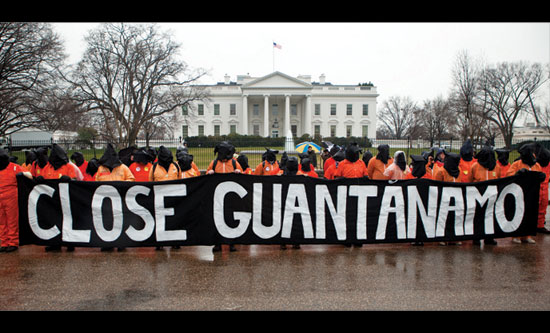
Nine years after President Obama promised to close the US torture camp in illegally occupied Guantanamo Bay in eastern Cuba, 41 prisoners continue to be held there. At least four are on hunger strike and, as we go to press, the campaigning charity Reprieve is warning that they are ‘edging close to death’.
The camp is situated within a US naval station at Guantanamo Bay, which dates back to the US-Spanish War of 1898. The Cuban people have always opposed this blatantly imperialist occupation and, since the Revolution, Cuba has demanded an end to the US presence. Lease payments have been sent annually from the US but since 1959 the Cuban government has not cashed any of the cheques.
In the 1990s the naval base was used to detain Haitian refugees and in January 2002 the US government of George Bush established a purpose-built military prison there to detain prisoners of its so-called ‘war on terror’, outside of the normal legal parameters governing prisoners of war. These detainees were held indefinitely, without trial and in inhumane conditions, which have been widely condemned by bodies such as Amnesty International and the UN. According to the International Committee of the Red Cross, the men held at Guantanamo were from 40 different countries; few had been charged with any crime and all were denied basic civil and legal rights. Rather than actually being ‘illegal combatants’ as the US alleged, most of those detained seem to have simply been in the wrong place at the wrong time; many were captured by bounty hunters in Afghanistan or Pakistan and handed over to the US in return for cash rewards.
Initially, the US administration refused to state how many men were held at Guantanamo, but, following a court ruling in 2006, it acknowledged that it was then holding 779 prisoners.
Gradually this number was reduced, following international pressure and legal action. As of August 2007, approximately 355 detainees remained. US officials said then that they intended to eventually put 60 to 80 of them on trial and to free the rest.
When Barack Obama became President, he promised to close the prison camp and in January 2009 he signed an executive order ordering its closure within a year; however, this never happened and in January 2017, 41 detainees remained. Three of these men were cleared for release in 2009 by Obama’s Guantanamo Review Task Force.
Throughout the time Guantanamo has been used as a prison camp, detainees have staged mass hunger strikes and other protests against their detention. These protests have generally been responded to with force-feeding and increased brutality and isolation. On 20 September 2017, in a sudden change of policy, the prison stopped force-feeding hunger-strikers and, at the same time, withdrew medical monitoring of their health and body weight. International supporters of the Guantanamo detainees now fear that, instead of either being freed or put on trial, as they have been demanding, prisoners such as Ahmed Rabbani and Khalid Qassim, who have been engaged in long protests, may simply be left to die in Guantanamo. Clive Stafford-Smith, the founder of Reprieve reports:
‘“I don’t want to die,” Ahmed told me, “but after four years of peaceful protest I am hardly going to stop because they tell me to. I will definitely stop when President Trump frees the prisoners who have been cleared, and allows everyone else a fair trial.”’
Nicki Jameson
Fight Racism! Fight Imperialism! 261 December 2017/January 2018




